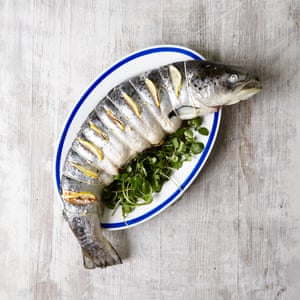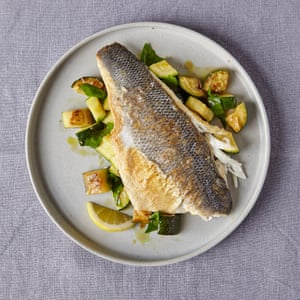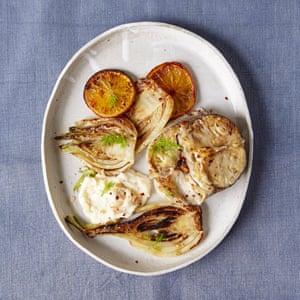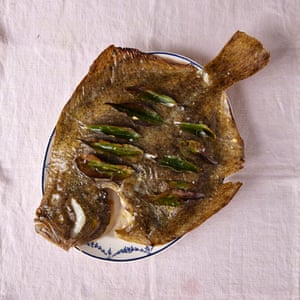Smoked mackerel, potato and green bean salad (pictured above)
Prep 10 min
Marinate 10 min
Cook 30 min
Serves 4
For the salad
1 small red onion, peeled and very thinly sliced
2 tbsp red wine vinegar
500g small waxy potatoes
300g green beans, trimmed
8 thin rashers smoked streaky bacon (optional)
6-8 smoked mackerel fillets, skin and pin-bones removed
1 small bunch flat-leaf parsley, leaves roughly chopped
Salt and black pepper
For the dressing
2 tsp dijon mustard
1 heaped tsp capers (optional)
6 tbsp olive oil
In a small bowl, submerge the red onions in the vinegar and leave to marinate for 10 minutes.
Cook the potatoes whole in boiling water for 15 minutes or until tender, then drain, peel and cut in half. Set aside.
Cook the green beans in boiling water for five minutes or until tender, and leave to cool.
In a frying pan over a moderate heat, gently fry the bacon (if using) for about 10 minutes, until crisp. Cut or break into pieces and set aside.
Tear the mackerel into large chunks and drain the red onions, reserving the vinegar.
For the dressing, mix all the listed ingredients with the reserved vinegar.
Put the warm potatoes into a large serving bowl, spoon over the dressing, then add the onions, beans, bacon (if using), mackerel and parsley. Season and serve.
From The Five O’Clock Apron by Claire Thompson (Ebury Press)
Roast salmon stuffed with watercress

Prep 30 min
Cook 30 min
Serves 6
115g unsalted butter, softened
Grated zest and juice of 1 lemon
200g watercress, woody stalks removed, roughly chopped, plus a handful more to serve
120g breadcrumbs
1 small banana shallot, peeled and finely chopped
Salt and black pepper
1 whole salmon, about 2kg-2.25kg, gutted
1 lemon, thinly sliced
Heat the oven to 170C/335F/gas 3½.
Put 90g of the butter, the lemon zest and half the juice, the watercress, breadcrumbs, shallot and plenty of seasoning in a bowl and mash together with your hands until well mixed. Spread the stuffing inside the cavity of the salmon.
Tie the salmon together at intervals with kitchen string, so that the space between each set of ties is roughly one portion – try to achieve equal portions while taking into account that the salmon tapers towards the tail end. Cut a slit in each segment of salmon and insert a half-slice of lemon (you may not need all the slices). You can protect the head and thinner tail end of the fish with a layer of well-greased foil, to slow their cooking.
Squeeze the remaining lemon juice over the fish and spread the remaining 25g butter over the top.
Roast for 30 minutes, or until it is cooked through, and is lovely and moist. Serve on a bed of watercress.
From Round to Ours by Laura Jackson and Alice Levine (Quadrille)
Sea bass with braised courgettes

Prep 15 min
Cook 30 min
Serves 4
100ml olive oil, plus 1 tbsp extra
2 garlic cloves, peeled and finely chopped
4 courgettes, cut into quarters lengthways then into 2.5cm chunks
1 good handful basil leaves, roughly torn
Salt and white pepper
4 sea bass fillets, about 180g-200g each, skin on
Juice of 1 lemon
1 lemon, cut into wedges, to serve
Heat the oven to 200C/390F/gas 6.
Heat the oil in a saucepan over a medium heat. Add the garlic and sweat for a minute without colouring. Next, add the courgettes and basil, then season with salt and white pepper, and mix well. Cook the courgettes for about 15 minutes, stirring regularly, until most of the water from the courgettes has evaporated and they have stewed down, leaving some in chunks and some completely broken down. Take off the heat and set aside.
Heat a large ovenproof frying pan with a tablespoon of olive oil over a medium heat. Put the sea bass in the pan skin side down, season with a little salt and cook for about 12 minutes, until the skin starts to take on some colour and begins to crisp. Carefully turn the fillets, put the pan into the oven and roast for about five minutes, until the flesh turns white and flakes easily.
To serve, reheat the courgettes over a low heat until they are just warm. Add a good squeeze of lemon and put a generous spoonful on to each warmed plate. Put a sea bass fillet on top and serve with a lemon wedge.
From The Seahorse by Mitch Tonks and Mat Prowse (Absolute Press)
Roast hake with fennel, orange and almond aïoli

Prep 10 min
Cook 20 min
Serves 4
Extra-virgin olive oil
4 hake steaks on the bone (250g-300g each)
Salt and black pepper
2 fennel bulbs, cut into 1cm slices, fronds retained
4 unpeeled garlic cloves, smashed
1 large orange, cut into 5mm slices
1 tsp dried chilli flakes
Juice of 1 lemon
Salt
For the aïoli
200g mayonnaise
1 garlic clove, peeled and grated
100g flaked almonds, toasted
To make the aïoli, fold the garlic into the mayonnaise and set aside.
Heat the oven to 200C/390F/gas 6. Heat some oil in a large frying pan over a medium heat until just smoking. Season the hake steaks, then fry flesh side down for three minutes, until golden; repeat on the other side. Transfer to a baking tray and set aside.
Fry the fennel and garlic until nicely coloured – about five minutes – then add to the hake tray. Add the orange slices and cook for a minute on each side, until they start to caramelise. Add to the hake, season and sprinkle with the chilli and some olive oil.
Bake for eight to 10 minutes, until the fish is cooked and starting to come away from the bone, and the fennel is cooked but still retains a little bite.
Meanwhile, coarsely crush the almond flakes in a pestle and mortar and stir into the aïoli.
Once the fish is ready, squeeze over the lemon juice and scatter with the fennel fronds. Serve straight from the tray, adding a dollop of almond aïoli to each plate.
From the Ducksoup Cookbook by Clare Lattin and Tom Hill (Square Peg)
Smoked haddock kichiri with pickled cauliflower

Prep 20 min
Pickle 1-2 hr
Cook 30 min
Serves 4
350ml whole milk
2 bay leaves
A few black peppercorns
300g smoked haddock
To serve
4 egg yolks
1 handful coriander leaves, chopped
Black pepper
For the pickled cauliflower
500ml white-wine vinegar
500g caster sugar
2 star anise
1 cinnamon stick
4 cloves
2 fresh Indian bay leaves
1 small cauliflower, florets thinly sliced
For the kichiri
200g yellow moong dal (lentils)
2 tsp ground turmeric
1 small onion, peeled and chopped
2 tbsp vegetable oil
2 tsp cumin seeds
2 tsp garlic, minced
2 green chillies, finely chopped
2 tsp ginger root, peeled and finely chopped
400g cooked basmati rice
100g unsalted butter, diced
Salt, to taste
Fish stock or water
For the pickled cauliflower, put the first six ingredients in a pan over a low heat and stir occasionally until all the sugar dissolves. Turn off the heat, add the cauliflower to the pickling liquor, then steep for one to two hours and store in a sterilised jar in the fridge.
To slow poach the haddock, pour the milk into a heavy-based saucepan over a low heat, simmer the milk with the bay leaves and peppercorns, then add the haddock skin side down and poach for 10 minutes. Strain off the liquid and spices, cool and flake the flesh, discarding any bones and skin.
To make the kichiri, put the moong dal and turmeric in a saucepan, cover with cold water, bring to a boil, then simmer for about 10 minutes, until the lentils have completely cooked down and all the water has been absorbed. Leave to cool, then puree in a blender.
Cook the onion in the oil on medium heat until soft and translucent. Add the cumin, garlic, chilli and ginger, stir, then add the lentil puree, rice, haddock and butter. Mix gently, until everything is combined, but don’t over-stir, as the fish will break. Add a little stock or water and more butter, if required to make it creamy and luxurious. Take off the heat and season, spoon into bowls, top with a raw egg yolk and serve with the pickled cauliflower, coriander and black pepper.
From Kricket by Will Bowlby (Hardie Grant)
Baked turbot

Prep 20 min
Cook 25 min
Serves 4
1 turbot, gills trimmed
Bay leaves
Olive oil, for drizzling
Juice of 1 lemon
100g butter, softened, in small lumps
Salt
1 small bunch tarragon, leaves chopped
Heat the oven to 240C/465F/gas 9 and put a large baking tray inside. Put the turbot on a chopping board, dark side up, and score diagonal slashes heavily across the skin. Fold the bay leaves lengthways and insert them into the slashes.
Once the tray is very hot, remove from the oven and drizzle it with oil. Put the fish on the tray and squeeze over the lemon juice, then add another drizzle of oil and a good scattering of salt over the top. Put the fish in the oven and roast for 20 minutes.
Once the turbot is out of the oven, scatter the butter over the fish and leave it to melt, then sprinkle over the tarragon. Serve the turbot butter from the roasting dish drizzled over any vegetable sides.
The best way to eat the turbot is to use a blunt knife to gently ease the flesh away from the bones, top layer first, then, once that has all gone, pick up the fish by the tail and turn it over to do the same with the underside. You can eat the skin or discard it – it’s up to you.
From The Hidden Hut by Simon Stallard (HarperCollins)
- Food styling: Sam Dixon. Prop styling: Anna Wilkins